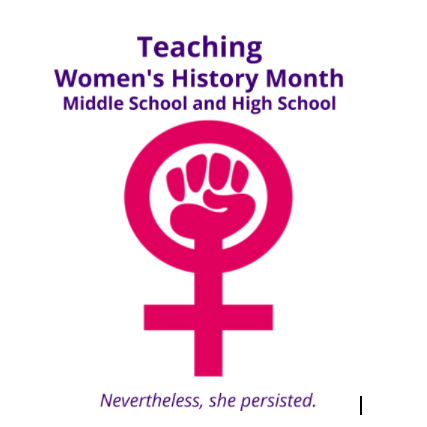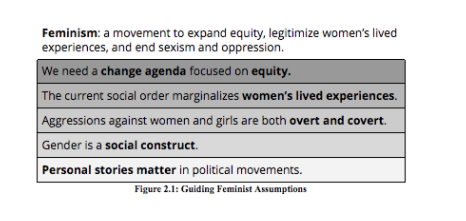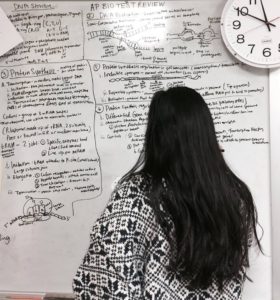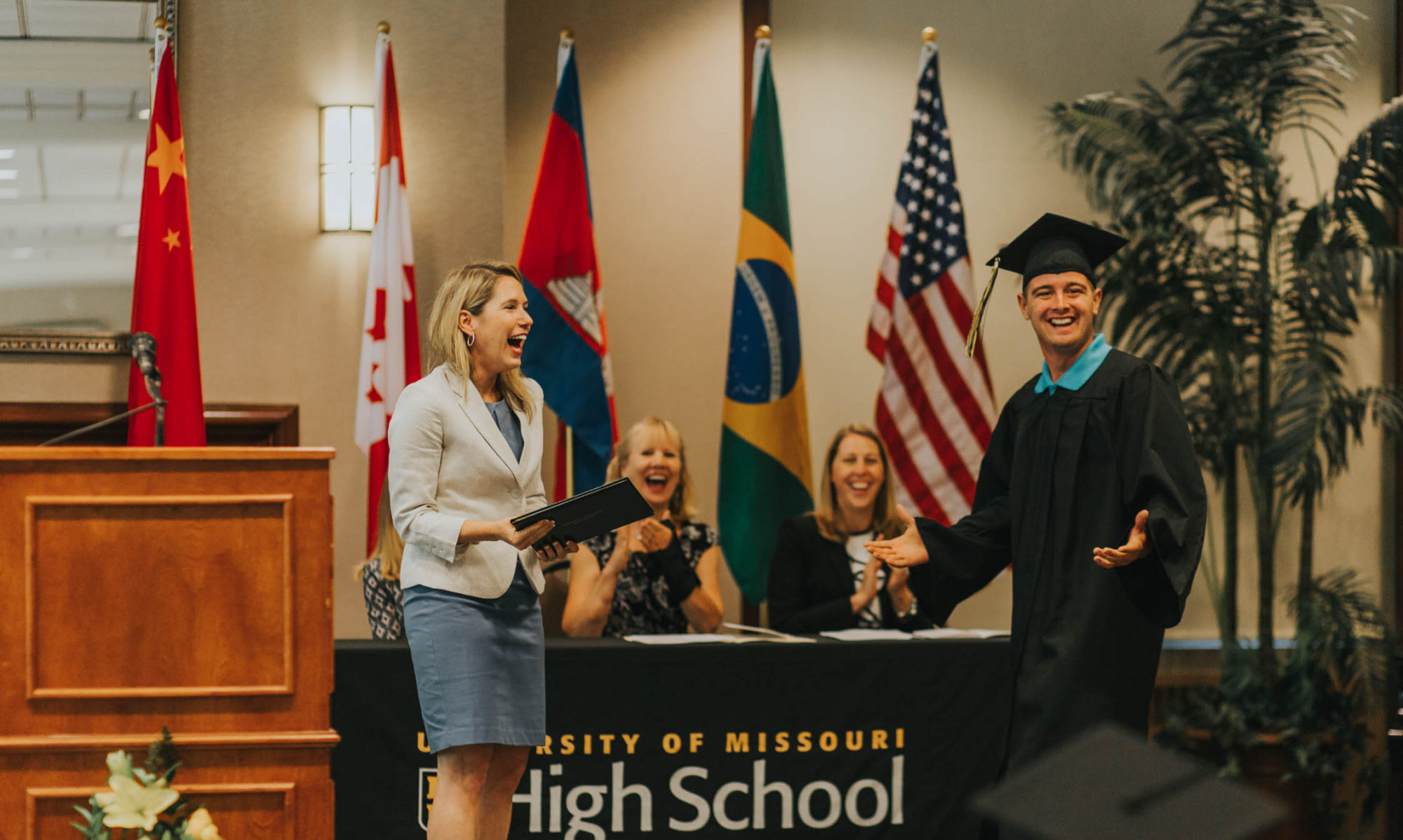
This post is part of our Culturally Responsive Teachers series
Girls and women make up 51% of the global population. Yet women’s stories, accomplishments, and experiences are too often left out of the curriculum. Women’s History Month is an important opportunity to engage in dialogues about equity, representation, and inclusion. The following resource is part of our series on culturally responsive teaching and includes activities and ideas for celebrating women’s history month in the middle and high school classroom. For some more history on Women’s History Month, see this student-friendly article published by Time magazine.
The theme of this year’s (2018) National Women’s History Project is Nevertheless She Persisted: Honoring Women Who Fight All Forms of Discrimination Against Women. As you and your students read stories, create art, watch videos, and complete projects, see if you can tie those activities back to the theme of persistence.
“Nevertheless she persisted” is a relatively new women’s rights saying and hashtag (2017). It originated from a reference to Senator Elizabeth Warren who spoke out against the unjust record of another senator.
Women’s History Month Guiding Questions:
- How can we all persist in the fight for justice?
- How have women persisted toward representation, equity, and inclusion?
Please note that our ideas are merely a starting place for incorporating these themes into your classroom. We know our lists are incomplete and we welcome your additional ideas in the comments below.
Stage-Setting
Ask your students to respond to the following questions:
- What are the differences between equality and equity? Why should we work for equity?
- What does it mean to honor all experiences as valid?
- What does oppression look like in our society? How can we work to end oppression?
These questions are a springboard for exploring feminism with students. After all, it wouldn’t be possible to teach Women’s History Month without considering the importance of women’s rights movements throughout history.
The following chart might give your students some common language around feminism.

Students (and adults) often carry a lot of assumptions and misinformation about feminism. These two videos by Chimamanda Adichie and Emma Watson help dispel these myths and explain why feminism is important for everybody.
Watch these videos with your students:
- Chimamanda Adichie, a Nigerian activist and author, gave this widely-watched TED talk called We Should All Be Feminists. She later published a book with almost the same content under the same title. Both the talk and the book can be excellent stage-setting pieces for your class.
- Emma Watson gave this speech at the United Nations launching the “HeforShe” campaign. In her speech, Watson discusses the way our gender stereotypes limit us.
- You can also print out a copy of the transcript for your students to follow along.
- Discussion questions:
- What surprised you about these speeches?
- How do these speakers define feminism?
- How is their definition similar or different from what you thought feminism meant?
- Which examples do you think are the most important or powerful in their speeches?
- What evidence of persistence can you identify in these speeches?
Media
- #MeToo Movement: Tarana Burke, a social activist, was the first person to use this hashtag on social media in order to call attention to the issue of assault and harassment against women. In 2017–2018, it gained viral global attention and has now been used by hundreds of thousands of people. Many famous people in the media, including actresses and singers, have shared their own stories using this hashtag. Writers in the #MeToo movement want to let victims know that they are not alone. This hashtag has also been translated into many languages, encouraging people all over the world to share their stories and put an end to violence against women.
- Hold a socratic seminar around the #metoomovement where students discuss their impressions of the movement, how social media can be used as a political tool, and their proposed call to action to make their local communities safer for women and girls.
- NPR podcast series 51%: NPR has launched a podcast series highlighting women’s perspectives on a host of important issues including healthcare, education, politics, the arts.
- Challenge students to work in teams to write and record their own submission to the podcast series.
Sciences
- Hold a science panel “inviting” women scientists who have changed the world. Assign students to work alone or in small groups to research famous women scientists. Some names to get you started include:
- Emilie du Chatelet
- Mary Somerville
- Lisa Meitner
- Marie Curie
- Tiera Guinn
- Elizabeth Blackwell
- Jane Goodall
- Mae Jeminson
- Katherine Freese
- Maria Goeppert Mayer
- Sara Seager
- Rosalind Franklin
- Barbara McClintock
- Rita Levi-Montalcini
- Gertrude Elion
- Two sources to help students begin their research: 17 Female Scientists Who Changed the World and 10 Historic Female Scientists You Should Know
- Case Study on Temple Grandin: Watch Dr. Grandin’s talk: “The world needs all kinds of minds.” Dr. Grandin is a scientist who was recently inducted into the Academy of Arts of Sciences for her work in the humane livestock handling industry. As a person on the autism spectrum, she has used her ability to think differently to make a huge difference in the treatment of animals. If students are interested in learning more about Dr. Grandin’s work, there is also a semi-autobiographical HBO film about her called Temple Grandin.
- Discussion questions:
- What surprised you in this talk?
- How has Dr. Grandin persisted?
- What does Dr. Grandin’s story and work teach us about inclusion and representation?
- Discussion questions:

Mathematics:
- Organize a Women in Math Event: Brigham Young University recently came under scrutiny after their advertisement poster for an event on Women in Math featured only men.
- Imagine that your class is hosting a Women in Math event (that features women mathematicians). Divide students into groups and assign them (or have them choose) a woman whom they would like to research. Each group should create their own Women in Math poster featuring the mathematician they researched. Students’ posters should include biographical information, significant contributions to mathematics, and any obstacles the mathematician had to overcome in order to persist in her professional path. Students can then present their poster to the class at your Women in Math event. Possible women mathematicians include:
-
-
- Hypatia
- Sophie Germain
- Mary Somerville
- Ada Lovelace
- Sofia Kovalevskaya
- Florence Nightingale
- Emmy Noether
- Dorothy Johnson Vaughan
- Marjorie Lee Browne
- Katherine Johnson
- Svetlana Jitomirskaya
- Maryam Mirzakhani
-
-
- Imagine that your class is hosting a Women in Math event (that features women mathematicians). Divide students into groups and assign them (or have them choose) a woman whom they would like to research. Each group should create their own Women in Math poster featuring the mathematician they researched. Students’ posters should include biographical information, significant contributions to mathematics, and any obstacles the mathematician had to overcome in order to persist in her professional path. Students can then present their poster to the class at your Women in Math event. Possible women mathematicians include:
Language Arts
- Literature Studies – Study the works of Sojourner Truth, Virginia Woolf, Maya Angelou, Emily Dickinson, Sylvia Plath, Mary Wollstonecraft, Charlotte Perkins Gilman, Tillie Olsen, Kate Chopin, Zora Neale Hurston, Margaret Atwood, bell hooks, Ursula K. Le Guin, Katha Pollitt, Gwendolyn Brooks, Jhumpa Lahiri, Rupi Kaur, Nayyirah Waheed, Edna St. Vincent Millay, Toni Morrison, Alice Walker
- Study the works of women poets including Nikki Giovanni, Maya Angelou, Rupi Kaur, Elizabeth Bishop, Sylvia Plath, Anne Sexton, Gwendolyn Brooks, Emily Dickinson, Marianne Moore, Mary Oliver, and Audre Lorde. Analyze these poets’ work for our themes of persistence, personal storytelling, mental health, and representation.
- Extension opportunity: Ask students to memorize or create a reader’s theater on their favorite poem from this study to perform at a class celebration. For inspiration, watch Sarah Kay’s performance of “If I should have a daughter.“
- Organize a Women’s History Month Book Club: Possible titles include:
-
- Speak by Laurie Halse Anderson,
- A Wrinkle in Time by Madeleine L’Engle (Middle School),
- I am Malala by Malala Yousafzai,
- Brown Girl Dreaming by Jacqueline Woodson,
- The Handmaid’s Tale by Margaret Atwood
- “The Yellow Wallpaper” by Charlotte Perkins Gilman
- “A Jury of Her Peers” by Susan Glaspell
- Review these books in advance for mature content that may or may not be appropriate for your grade-level courses.
-
- Host a Socratic Seminar on Kate Chopin’s “The Awakening”:
- You can also find three lessons on this short story from the National Endowment for the Humanities website.
- Additional resource: The podcast Text Messages: Recommendations for Adolescent Readers has an episode on feminist books for teens.
Social Sciences
- Exploring History: Divide students into 50-year groups beginning with 1700. Ask each group to research the important legislation, major trends, and accomplishments in the women’s rights movements. This resource from the National Women’s History Project is a great starting place.
- Intersectionality: Kimberlé Crenshaw coined the term “intersectionality” to explain how our multiple identities (e.g. race, class, gender, ethnicity, etc.) intersect to create complex and compounding experiences in social space. For example, what it means to be a Black woman in America is different from what it means to be a Black man in America or a Latina woman in America. Ask students to make identity maps exploring their various personal identities.
- Proposals: Challenge students to write proposals for which woman who should be featured on the new $20 bill.
- Explore mental health: Charlotte Gilman’s “The Yellow Wallpaper”: Read and analyze this story together. Then, encourage students to research treatment options for mental health, particularly for women, around the time this story was published (1892).
- Extension opportunity: Students can also compare and contrast mental health treatment and/or stigma from the 19th century to today.
Art
- Four Women Artists – Divide students into four groups to research and create art: Georgia O’Keeffe, Frida Kahlo, and Helen Frankenthaler, and Annie Leibovitz.
- Host a gallery event: In groups, students should research their assigned artist, learning more about her biography, key themes, and style. Then as individuals, students should create original works in the style of their artist. Host a gallery event showcasing the biographies of these artists as well as the students’ works of art.
- Note the Annie Leibovitz group will need access to a camera. The other groups will need paint.
- Host a gallery event: In groups, students should research their assigned artist, learning more about her biography, key themes, and style. Then as individuals, students should create original works in the style of their artist. Host a gallery event showcasing the biographies of these artists as well as the students’ works of art.
- Collage – Provide students with magazines that they can go through to cut out words and pictures to create a collage. Collages should include images, text, and a call to action. Potential collage themes include:
- Gender & Culture
- A Feminist World
- Body Image
- Rewriting Gender Stereotypes
- “Nevertheless She Persisted” (this year’s National Women’s History Project theme)
Additional resources:
- The National Education Association (NEA) offers resources and lesson plans for Grades 6-8 and Grades 9-12.
- Teaching History offers resources for Women’s History Month, including quizzes, printables, and lesson plans.
- The National Women’s History Museum has an extensive library of resources for students and teachers, including biographies, lesson plans, posters, and electronic field trips.
- The website Science NetLinks contains lesson plans that study the achievements of women in STEM fields.
